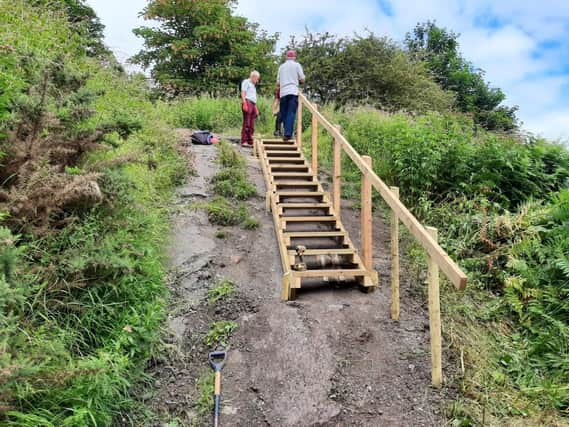Section of Cleveland Way on collapsed old railway track near Sandsend re-opens following winter landslip


Two new timber staircases have been built by the North York Moors National Park Authority for walkers on the slumped ground near Sandsend, which runs over the trackbed of the old Whitby to Loftus railway line. A diversion had been in place since February.
The route is also part of the new England Coastal Path, a planned National Trail which is opening in segments.
Advertisement
Hide AdAdvertisement
Hide AdThe wet winter of 2021 caused several instances of erosion and cliff collapse on the soft clay coastline between Whitby and Saltburn.
A landslip at Runswick Bay led to warnings to visitors to stay away from the cliffs while walking on the beach, and there was a major vegetation slippage at Cowbar Nab above the village of Staithes. A path leading to Port Mulgrave beach had to be closed after a landslip and two more sections of the Cleveland Way, near Whitby and Saltburn, had to be cordoned off and moved further inland following severe erosion.
The Sandsend Trail includes two railway tunnels at Kettleness and Sandsend that are relics of one of the least profitable branch lines in British railway history - the Whitby to Loftus line.
The route closed in 1958 having been beset by structural issues from the outset, and the tunnels have been blocked off and abandoned ever since.
Advertisement
Hide AdAdvertisement
Hide AdAn ambitious plan to re-open them for cyclists using the Cleveland Way was proposed earlier this year and is being investigated.
Although part of the old line is a footpath, it is not currently suitable for cycling or disabled access due to its steep gradients and steps.
Re-opening the tunnels would not be easy, partly due to the pressures of cliff erosion in the area. The tunnels were originally built further inland for this reason, after part of the intended route along the clifftop fell into the sea in the 1880s.
In 2008, the northern portal of the mile-long Sandsend Tunnel partially collapsed, and the southern half is prone to flooding.
Advertisement
Hide AdAdvertisement
Hide AdThe North York Moors National Park Authority warned that the project is in the very early stages and that significant engineering surveys will have to undertaken to establish the feasibility and costs of such a scheme.
One of the reasons the loss-making railway was recommended for closure - several years before the Beeching axe period - was the cost of maintaining the tunnels, which exceeded the revenue generated from ticket sales. Trains were only heavily used during summer weekends after the war, and the closure meant that Staithes, Hinderwell, Kettleness, Sandsend and Whitby West Cliff lost their stations. Most are now private houses, and Kettleness is a Scout activity centre.
A short section of the line remained open for freight trains serving the potash mine at Boulby.